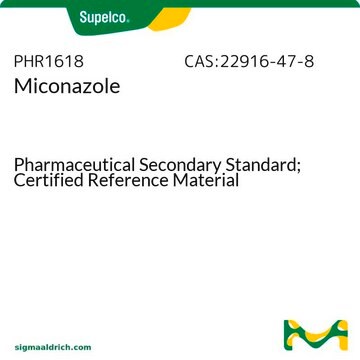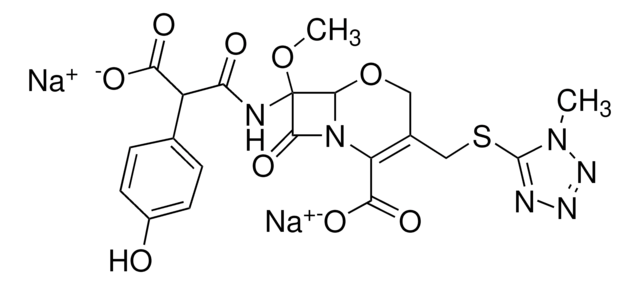M3512
(±)-Miconazole nitrate salt
imidazole antibiotic
Sinónimos:
1-(2,4-Dichloro-β-[(2,4-dichlorobenzyl)oxy]phenethyl)imidazole
About This Item
Productos recomendados
Nivel de calidad
actividad óptica
[α]/D ±0.10° (Specific Rotation (BP))
color
white to off-white
espectro de actividad antibiótica
fungi
mycobacteria
Modo de acción
enzyme | inhibits
cadena SMILES
ClC1=CC(Cl)=CC=C1C(OCC2=CC=C(Cl)C=C2Cl)CN3C=CN=C3.[O-][N+](O)=O
InChI
1S/C18H14Cl4N2O.HNO3/c19-13-2-1-12(16(21)7-13)10-25-18(9-24-6-5-23-11-24)15-4-3-14(20)8-17(15)22;2-1(3)4/h1-8,11,18H,9-10H2;(H,2,3,4)
Clave InChI
MCCACAIVAXEFAL-UHFFFAOYSA-N
¿Está buscando productos similares? Visita Guía de comparación de productos
Categorías relacionadas
Descripción general
Aplicación
Acciones bioquímicas o fisiológicas
Nota de preparación
Aplicación
Palabra de señalización
Warning
Frases de peligro
Consejos de prudencia
Clasificaciones de peligro
Acute Tox. 4 Oral - Skin Sens. 1
Código de clase de almacenamiento
11 - Combustible Solids
Clase de riesgo para el agua (WGK)
WGK 3
Punto de inflamabilidad (°F)
Not applicable
Punto de inflamabilidad (°C)
Not applicable
Equipo de protección personal
dust mask type N95 (US), Eyeshields, Faceshields, Gloves
Certificados de análisis (COA)
Busque Certificados de análisis (COA) introduciendo el número de lote del producto. Los números de lote se encuentran en la etiqueta del producto después de las palabras «Lot» o «Batch»
¿Ya tiene este producto?
Encuentre la documentación para los productos que ha comprado recientemente en la Biblioteca de documentos.
Los clientes también vieron
Chromatograms
application for HPLCapplication for HPLCapplication for HPLCNuestro equipo de científicos tiene experiencia en todas las áreas de investigación: Ciencias de la vida, Ciencia de los materiales, Síntesis química, Cromatografía, Analítica y muchas otras.
Póngase en contacto con el Servicio técnico












